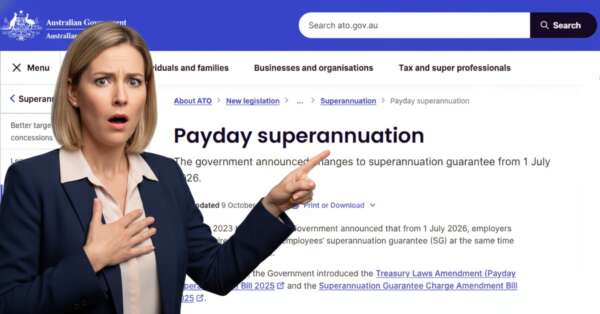2025 ATO Compliance Focus – Quick Summary
The ATO has intensified compliance activities targeting the $35.6 billion owed by small businesses, with enhanced data matching programs and stricter enforcement measures introduced from July 2025. Key changes include AI-powered data matching across 60+ sources, mandatory monthly GST reporting for 3,500 non-compliant businesses, aggressive director penalty enforcement, and expanded debt recovery powers. This represents a fundamental shift from education to enforcement.
Click or tap to view the official ATO list of focus areas for small business here.
Frequently Asked Questions
What is the ATO’s 2025 compliance focus targeting?
The ATO’s 2025 compliance focus is targeting five main areas: contractor income under-reporting (especially in construction, IT, cleaning, and security), GST compliance failures, incorrect small business boost claims, director penalty notice enforcement, and inflated work-related expense deductions. The ATO has identified $35.6 billion owed by small businesses and is using enhanced technology to collect it.
How will the ATO’s enhanced data matching affect my business?
The ATO’s enhanced data matching now uses AI to cross-reference over 60 data sources including banks, digital platforms, crypto exchanges, property records, and insurance providers. This technology can detect discrepancies in near real-time between your reported income and third-party data. Even minor mismatches between your BAS lodgements and actual transactions can trigger compliance action.
What are the penalties if my business is caught in the ATO’s compliance activities?
Penalties in the ATO’s compliance activities range from administrative penalties of 25-75% of the tax shortfall, director penalty notices making directors personally liable for company debts, potential criminal prosecution for serious offences, and garnishee orders freezing bank accounts. The ATO can also report defaults to credit bureaus and initiate wind-up proceedings for persistent non-compliance.
Worried about your compliance position? Get a professional review here to protect your business.
The five key areas ATO is targeting (and why now)
 I’ll be completely honest with you – many client meetings this year have started with variations of these exact questions, and for good reason!
I’ll be completely honest with you – many client meetings this year have started with variations of these exact questions, and for good reason!
The ATO isn’t messing around anymore. They’ve identified a $17.7 billion “tax gap” – the difference between what should be collected and what actually gets paid – and they’re coming after it with unprecedented resources and technology.
Here are the five areas where businesses are getting hit hardest:
Contractor income under-reporting is the big one. If you’re in construction, IT services, cleaning, courier work, or security, you’re squarely in the crosshairs. The ATO knows that cash payments and “off the books” arrangements are rife in these industries, and they’re using data matching to catch businesses paying contractors without issuing payment summaries, or contractors not declaring the full amount they’ve received.
GST compliance failures have become a massive focus area. This includes everything from not registering for GST when you should, to claiming input tax credits for things that don’t qualify, to the classic “shadow economy” activities where cash transactions mysteriously don’t make it onto BAS statements. The ATO estimates billions in lost GST revenue here.
Small business boost measure claims are under intense scrutiny. Remember those technology investment boosters, training expenditure incentives, and skills and training boosts that were introduced to help businesses? Well, the ATO has discovered widespread incorrect eligibility claims and calculation errors, and they’re auditing these systematically.
Director penalty notices have become the ATO’s weapon of choice for company tax debts. Directors are being held personally liable for their company’s unpaid super, PAYG withholding, and net GST liabilities. This isn’t just about the original debt anymore – it includes penalties and interest charges too.
Work-related expense claims and rental property deductions complete the hit list. The ATO’s data matching can now cross-reference your claimed expenses against actual purchases and lifestyle indicators. If your deductions don’t align with what their systems expect, you’ll get a please explain letter.
Three of my clients have already been contacted about different issues this year. One got pinged for contractor payments that didn’t match the payment summaries issued, another faced questions about GST credits claimed on vehicle purchases, and the third received a director penalty notice for outstanding super contributions that dated back eighteen months.
The timing isn’t coincidental either – the ATO has $35.6 billion in outstanding debt on their books, with small businesses owing the lion’s share. They’ve been given extra funding and enhanced powers to collect it, and they’re under political pressure to show results.
Is your business in a high-risk category? Let’s assess your exposure together before the ATO comes knocking.
The technology behind the crackdown: how ATO finds you
The ATO’s technological capabilities in 2025 would make George Orwell nervous.
They now use over 60 sophisticated identity-matching techniques and AI-driven analytics to cross-reference millions of data points from banks, employers, super funds, government agencies, crypto exchanges, digital platforms, and even insurance companies. This happens in near real-time, meaning discrepancies can be flagged before you’ve even finished your coffee.
Here’s how they catch businesses now:
Real-time access to business bank transactions: The ATO receives regular feeds from all major banks showing business account activity. They can see patterns of cash deposits that don’t align with reported income, unusual transaction patterns, and lifestyle purchases that seem inconsistent with declared business performance.
Cross-referencing contractor payments: When you pay a contractor, that information gets matched against what the contractor declares as income. If there’s a discrepancy, both parties get flagged. This works both ways – contractors claiming they earned more than businesses report paying them, or businesses failing to issue proper payment summaries.
Third-party data matching: The ATO gets information from payment processors, ride-sharing platforms, online marketplaces like eBay and Etsy, short-term rental platforms like Airbnb, crypto exchanges, share trading platforms, and even insurance companies. Every digital footprint you create generates data that goes into their matching systems.
Predictive analytics for audit targeting: Their AI systems analyse patterns to predict which taxpayers are most likely to have compliance issues. They look at industry benchmarks, expense ratios, profit margins, and lifestyle indicators to identify businesses that warrant closer inspection.
International data sharing: Through OECD agreements, the ATO gets information about offshore accounts, international transactions, and foreign income. The days of thinking overseas activities are invisible to the ATO are long gone.
I had a tradesperson client who was contacted after ATO data matching revealed payment summaries from multiple building companies totalling $180,000, but he’d only declared $120,000 as business income in his tax return. The ATO knew about the discrepancy before he’d even realised he’d made the mistake.
Another client – a small retailer – got flagged because her business loan repayments and personal living expenses couldn’t be justified by her declared business income. The ATO’s systems had calculated that her lifestyle required significantly more income than she was reporting, which triggered a review.
The scariest part isn’t the technology itself – it’s how automated the whole process has become. Many compliance actions now start without human intervention. The system identifies discrepancies, generates letters, and initiates recovery action with minimal human oversight in the early stages.
Need help understanding what data ATO can access about your business? Contact us for a confidential discussion about your exposure.
New enforcement powers and what they mean for directors
The ATO’s enforcement arsenal in 2025 looks more like something from a debt collection agency than a tax office, and frankly, it’s working exactly as they intended.
Director penalty notices have become their standard operating procedure rather than a last resort. Under these provisions, directors become personally liable for their company’s unpaid super guarantee, PAYG withholding, and net GST amounts – even if the company has no assets. The notice gives directors 21 days to either pay the debt, put the company into voluntary administration, or wind it up. Miss the deadline, and the director’s personal assets are fair game.
I had to explain to a director client last month why his personal home was suddenly at risk because of his company’s outstanding super liabilities. He genuinely thought that incorporating protected his personal assets from business debts – and normally it does. But not with director penalties.
Here’s what the ATO can do now that they couldn’t (or wouldn’t) do before:
| Enforcement Action | What It Means | Timeline | Personal Impact |
|---|---|---|---|
| Director Penalty Notice | Personal liability for company debts | 21 days to comply | Home, personal assets at risk |
| Garnishee Orders | ATO takes money directly from accounts | Immediate | Bank accounts frozen |
| Credit Bureau Reporting | Tax debts reported to credit agencies | Within 28 days | Credit rating destroyed |
| Wind-up Proceedings | Court action to close company | 3-6 months process | Business operations cease |
| Asset Seizure | Physical removal of business assets | After 14 days notice | Equipment, vehicles taken |
Garnishee action and bank account freezing has become frighteningly common. The ATO can direct your bank to freeze accounts and redirect payments to them without going to court first. I’ve seen businesses unable to pay staff wages because their operating accounts were suddenly frozen.
Wind-up proceedings are no longer rare events for persistent non-compliance. The ATO will petition the court to close down businesses that consistently fail to meet their tax obligations. The directors end up banned from managing corporations, and the business ceases to exist.
Credit bureau reporting is perhaps the most insidious new power. Tax debts over $100,000 that remain unpaid for 90 days get reported to credit agencies. This destroys the business’s credit rating and makes obtaining future financing nearly impossible.
Enhanced whistleblower protections are encouraging employees, contractors, and even competitors to report tax evasion. The ATO offers financial rewards for information leading to successful recovery of unpaid tax, and the protections for informants have been significantly strengthened.
What’s particularly concerning is how quickly these enforcement actions can escalate. The old days of lengthy negotiation periods and multiple chances to fix problems are largely gone. The ATO’s approach now is “pay first, argue later” – and they have the legal powers to enforce that philosophy.
The psychological impact on directors has been enormous. Many are now personally guaranteeing business debts they never thought they’d be liable for, and the stress of potential personal asset loss is causing some to simply walk away from viable businesses rather than risk their family home.
Directors need to understand their personal liability – book a consultation here to protect yourself and your assets.
Monthly GST reporting: 3,500 businesses affected from April 2025
This is where the ATO’s crackdown gets really personal – and expensive.
Starting in April 2025, the ATO began forcing businesses with poor GST compliance histories onto monthly GST reporting instead of the standard quarterly cycle. About 3,500 businesses have been selected for this “special treatment”, and let me tell you, none of them are happy about it.
The criteria for getting selected aren’t publicly disclosed, but from what I’ve seen with clients, it’s typically businesses that have:
- Late or missed GST lodgements in the past 24 months
- Significant variations between estimated and actual GST liabilities
- Outstanding GST debts that required payment arrangements
- Audit findings related to GST compliance issues
- Industry risk factors (cash-intensive businesses, labour hire, construction)
The cash flow impact is brutal. Instead of putting aside GST for three months and paying it quarterly, these businesses now need to calculate, lodge, and pay GST every month. For a business turning over $2 million annually with $200,000 in monthly GST liability, this represents a fundamental change to cash flow management.
We helped one client – a building company – avoid monthly reporting by improving their lodgement record and establishing a payment arrangement for historical debts. But it was touch and go, and the additional compliance costs of monthly reporting would have added roughly $3,600 per year to their accounting fees alone.
Warning signs your business might be selected:
- BAS lodgements more than 14 days late in the past year
- GST payment arrangements or deferrals requested
- Significant amendments to previous GST returns
- Industry classification in high-risk categories
- Inconsistent reporting patterns or unusual refund claims
The administrative burden increase is significant too. Monthly GST reporting means:
- 12 GST calculations per year instead of 4
- Monthly reconciliation of input tax credits
- More frequent bookkeeping requirements
- Additional software and professional fees
- Increased audit and penalty risk if mistakes are made
For businesses already struggling with cash flow, monthly GST reporting can be the straw that breaks the camel’s back. The reduced cash float and increased compliance costs create a perfect storm that can push marginal businesses into insolvency.
The worst part is that getting off monthly reporting isn’t easy. The ATO requires a sustained period of perfect compliance – typically 12 months of on-time lodgements and payments – before they’ll consider returning a business to quarterly reporting.
Concerned about monthly GST requirements? Let’s review your compliance history together and develop a strategy to keep you on quarterly reporting.
How to protect your business: proactive compliance strategies
Right, enough doom and gloom. Let me tell you exactly how to protect your business from becoming another casualty of the ATO’s crackdown.
The best defence is getting ahead of ATO attention through proactive measures, and I’ve developed a systematic approach that’s kept my clients out of trouble – even those in high-risk industries.
Immediate health check (do this within 30 days):
Start with your lodgement history – every BAS, IAS, and income tax return for the past three years. Are they all lodged on time? Any missed deadlines trigger risk flags in ATO systems. If you’ve got outstanding returns, get them lodged immediately, even if you can’t pay the full amount owing.
Review your payment history for any late payments, payment arrangements, or outstanding debts. The ATO’s computer systems flag businesses with payment compliance issues for closer scrutiny. If you owe money, establish a payment arrangement before they chase you.
Check your record-keeping systems. Can you substantiate every claim on your last three BAS returns? Every input tax credit claimed? Every contractor payment made without issuing payment summaries? If not, you’re sitting on potential problems.
Audit your contractor arrangements – are they genuinely contractors or should they be treated as employees? The ATO’s crackdown on sham contracting is brutal, and the penalties for getting it wrong include super guarantee charge, PAYG withholding penalties, and payroll tax liabilities.
60-day improvements:
Implement monthly bookkeeping reconciliation even if you lodge quarterly. This catches discrepancies before they become ATO problems and ensures your BAS lodgements are accurate.
Set up automated tax provisioning – put aside GST and PAYG withholding as you earn it, not when the BAS is due. Cash flow problems cause most compliance failures, and this simple step prevents most of them.
Update your business systems to separate business and personal transactions clearly. Mixed personal/business expenses are audit triggers, and the ATO’s data matching can detect lifestyle purchases that seem inconsistent with reported business income.
Document your business processes, especially around cash handling, contractor payments, and input tax credit claims. Good documentation is your best defence if the ATO comes knocking.
90-day strategic improvements:
Consider voluntary disclosure if you’ve identified historical compliance issues. The ATO’s treatment of voluntary disclosures is significantly more favourable than discoveries through their compliance activities. Coming forward before they find you shows good faith and typically reduces penalties.
Establish relationships with professional advisers who understand ATO compliance requirements. The cost of professional advice is insignificant compared to the cost of getting compliance wrong.
Review your business structure for tax efficiency and ATO visibility. Some structures attract more attention than others, and structural changes might reduce your audit risk profile.
Build ATO relationship management strategies – respond promptly to any ATO correspondence, keep them informed of business changes that might affect your tax obligations, and maintain accurate contact details in their systems.
Here’s how we helped one client avoid an audit through proactive measures: We identified that his contractor payments didn’t align with his payment summary declarations, fixed the discrepancies through voluntary disclosure, implemented monthly reconciliation processes, and established clear documentation procedures. Cost: about $3,500 in professional fees. Potential cost of ATO audit and penalties: over $45,000.
The key insight is this: proactive compliance isn’t just about following the rules – it’s about demonstrating to the ATO’s computer systems that your business is low-risk and doesn’t warrant closer attention.
Don’t wait for ATO to come knocking – get your compliance house in order now before small problems become expensive disasters.
This article provides general information only and shouldn’t be considered personal financial advice. The ATO’s 2025 crackdown affects different businesses in different ways – always get professional advice for your specific situation and compliance requirements.












